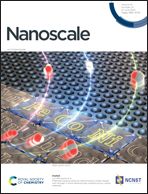InAs nanowire arrays for room-temperature ultra-broadband infrared photodetection†
Abstract
Detection of short-wave infrared (SWIR) and mid-wave infrared (MWIR) emissions remains challenging despite their importance in many emerging applications, including night vision, space imaging and remote sensing. III–V compound semiconductor materials such as InAs have an ideal band gap covering a spectral regime from near-infrared (NIR), SWIR to MWIR. However, due to their high dark current, InAs photodetectors normally require a low-temperature operation, which has greatly limited their practical applications. Here, we report the engineering of InAs nanowire arrays to achieve efficient photodetection of light at wavelengths ranging from NIR to MWIR (3500 nm). By using selective area metal–organic vapour-phase epitaxy, we optimise the nanowire growth temperature and V/III ratio to achieve wurtzite (WZ)-based InAs nanowire arrays with a high WZ density of ∼67%. Due to the n-type background doping of the InAs nanowires and the p-type InAs substrate used for nanowire growth, a p–n junction is formed, and an ultrawide room-temperature photoresponse ranging from 500 to 3500 nm is obtained under zero bias. It is found that the waveguide modes supported by the InAs nanowires result in a high peak responsivity of 0.44 A W−1 and a detectivity of 1.25 × 1010 cm √Hz W−1 at a wavelength of 1600 nm, a bias voltage of only −0.1 V and a relatively high operating temperature of 150 K. Such a strong light trapping effect in the InAs nanowires also leads to significantly lower reflection compared to that observed in planar photodetectors, and thus strong absorption in the substrate extending the photoresponse up to the InAs bandgap edge of 3500 nm. Our work shows that through careful material optimisation and device design, InAs nanowire arrays are promising for the development of high-performance ultra-broadband infrared photodetectors for wavelengths ranging from NIR, SWIR to MWIR.



 Please wait while we load your content...
Please wait while we load your content...